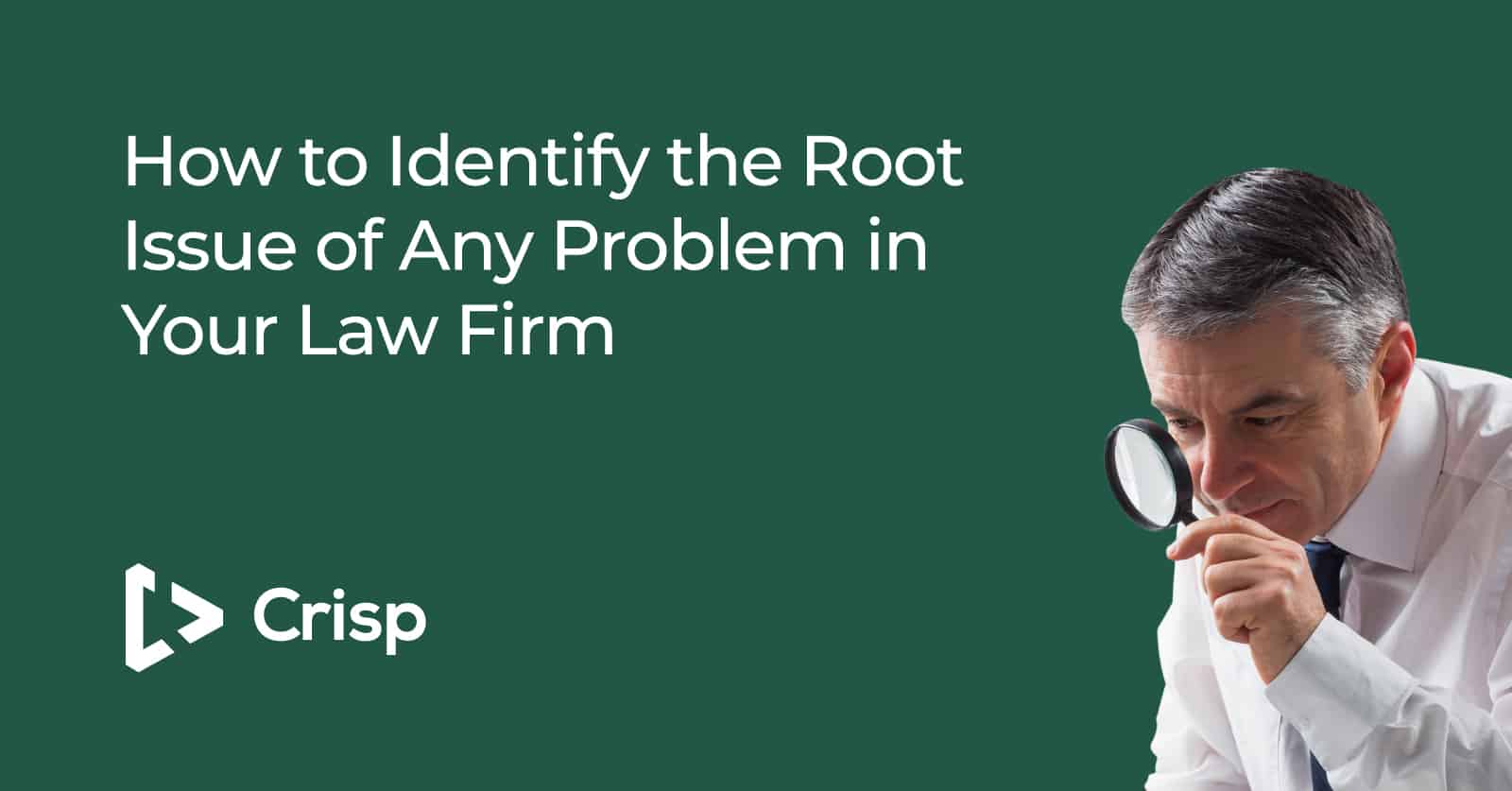As with any organization, a law firm may encounter various problems that can hinder its ability to operate efficiently and effectively. These challenges can come in many forms, such as:
- Team misalignment
- High turnover
- Financial difficulties
- Lack of new clients
- Decreased productivity
- And so much more
If any of these problems sound like what’s happening at your firm, it’s time to get to the root cause of these issues — and we’re going to help.
While these problems can manifest themselves in many different ways, they likely have more in common than you think. In this exclusive guide, we’re going to show you what it is.
Assess the Issue
Ask yourself: What happened?
When trying to identify the root cause of a problem within a law firm, it’s important to start by clearly defining the issue at hand. This will involve gathering information about the event or situation, such as:
- When it occurred
- Who was involved
- What the immediate consequences were
- Who or what was affected by it
It may also involve gathering feedback from team members, clients, partners, or other stakeholders to gain a better understanding of the impact of the issue on the firm as a whole.
Once the issue has been clearly defined, it’s important to understand the underlying causes and contributing factors. This may involve analyzing data or conducting interviews to identify any trends or patterns that may be contributing to the issue.
Note: Don’t forget that you may have to examine the firm’s organizational structure, culture, and systems to identify any underlying issues that may be contributing to the problem.
When you understand the specific event or situation that’s causing the problem, law firm leaders like you can develop strategies to address the issue and prevent similar issues from occurring in the future, such as implementing new policies or procedures, revising the firm’s business strategy, or investing in new technologies or training programs.
End goal: Identify the underlying cause of the problem to implement effective solutions that will create positive change over time.
Examine the Trends
Ask yourself: What has been happening? Is there a pattern?
Trends refer to changes or shifts in data points over time. This can include changes in revenue, client retention rates, employee satisfaction, or any other metric that may be relevant to the issue at hand. Patterns refer to recurring or consistent themes or behaviors that may be contributing to the issue.
In other words, how did you get here in the first place?
When trying to identify the root cause of a problem within a law firm, it’s important to examine the trends and patterns that have emerged over time.
If your firm is experiencing a decline in revenue, it may be helpful to analyze revenue data over several years to identify any consistent trends or patterns. Is the decline due to a single factor, such as losing a major client or a shift in the market, or is there a more complex set of factors at play?
If the firm is struggling to retain top talent, it may be helpful to analyze hiring and retention data over several years to identify any consistent patterns. Is there a consistent shortcoming in the hiring process or in the promotion and compensation structure that is contributing to the issue?
Whatever the problem is, you must analyze everything at play. When that’s done, law firm owners like you can get closer to the root cause of a problem and develop strategies to address it. This may involve overhauling policies or procedures, investing in new programs, or shifting your long-term strategy.
End goal: Understand the trends and patterns around a firm-wide stuck to gain clarity over the big picture.
Identify the Structure
Ask yourself: What factors are contributing to this pattern?
Organizational structure refers to the formal framework that defines the roles, responsibilities, and relationships within an organization. This can include the reporting structure, division of labor, policies and procedures, and communication channels. Organizational systems refer to the processes, procedures, and routines that guide how work is done within the organization.
If your firm is experiencing low productivity or high inefficiency, you may want to examine the division of labor and communication channels to identify bottlenecks or areas of overlap. If there are inconsistencies in the way work is done or in the application of policies and procedures, it may be helpful to examine the underlying systems and processes to identify areas for improvement.
When you do this, you can identify areas for operational improvement and devise strategies to shift the structure and systems in a more positive and productive direction.
End goal: Redefine roles and responsibilities, streamline communication channels, and revise policies and procedures.
Determine the Mindset
Ask yourself: What assumptions or belief system is in place perpetuating the issue?
Mindset can be defined as the set of beliefs, attitudes, and assumptions that shape how we view the world, ourselves, and others. These beliefs and attitudes can either move forward or hold back our ability to solve problems and achieve our goals.
When trying to identify the root cause of a problem in your law firm, it’s important to examine the underlying mindset that may be contributing to the issue.
If your law firm is struggling with high turnover rates, it could be helpful to examine the assumptions and beliefs that leaders and team members hold about work-life integration, career advancement, and firm engagement.
If your firm’s culture allows complacency and a simple checking of to-do boxes over tangible results, it may encourage a cycle of low performance, entitlement, and disengagement — whether you mean to or not.
Or if you’re noticing that your law firm is struggling to attract and retain talent, you may want to examine the underlying assumptions and biases that may be exacerbating the issue. If leaders assume that only candidates from certain schools or backgrounds are qualified for certain positions, they may be overlooking great-fit candidates with more aligned strengths and values.
When you take the time to examine the underlying mindset and assumptions that may be contributing to a problem, law firm leaders like you can identify areas for improvement and implement strategies to shift the culture and mindset in a more positive and productive direction.
End goal: Attract and retain high-performing team members, challenge assumptions and biases, and foster a growth mindset that values innovation and learning.
Final Thoughts
Though your problems might seem insurmountable right now, that doesn’t mean they’re going to be that way forever — it simply means that you need to get to the root of the issue.
Now that you’ve gotten through this guide, you understand that you aren’t alone in your challenges running your law firm.
In fact, they’re much more common than you think.
Better yet, they’re easier to solve than you ever could have imagined.
If you’re ready to solve those root issues holding your business back, we’re here to help. Contact us today and connect with a law firm growth strategist to put your firm on the fast track to success.
Let’s do this.












